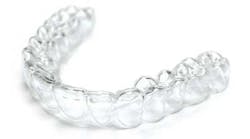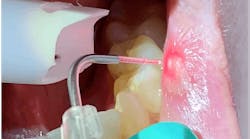Orthodontic tooth movement with clear aligners: seeing results with the invisible
“I want those invisible braces, the ones nobody can see.”
We’ve all heard this wish from a gap-toothed patient. No one wants to go through life with malaligned teeth, but few people want to be seen with metal train-track braces, either. One aligner manufacturer uses this evocative teaser on its website: “No one needs to know.”
The field of orthodontics made a quantum leap with a technique for removable clear aligners by Chishti and Wirth in 1997, (1) and today it really is possible to straighten teeth with nearly invisible appliances.
RELATED |An argument for clear aligners and clear braces
Orthodontic tooth movement (OTM) with clear aligners involves the fabrication of a series of incrementally different aligners for top and bottom teeth that are similar in appearance to whitening trays or an athletic mouthguard. The first pair of aligners may be no different from the patients’ normal dentition, so they can get used to wearing them. Aligners are typically changed every two to four weeks, and each new set is slightly different from the last to gradually shift teeth into place. Treatment can take up to two years, depending on case difficulty and patient compliance. A patient may need fewer than five aligners, or more than 20.
Records required to begin aligner treatment can include a case submission form, upper and lower PVS impressions, PVS bite registration, full-mouth or panoramic X-rays, and facial and intraoral photographs. (2) Sometimes digital scans can be used instead of impressions and bite registration.
At the lab, a treatment plan is produced that includes 3D models of the patient’s present and projected dentition, and information on how many aligners will be needed, along with any IPR (interproximal reduction) recommended. For intrusions and extrusions, acrylic buttons may be attached to teeth temporarily to add force to movement.
Success depends heavily on compliance. Patients are generally happier with aligners to begin with, because they’re nearly invisible and can be taken out for brushing and eating. The disadvantage of aligners is that the patient has complete control over their use. Aligners must be worn 20 to 22 hours per day for treatment to remain on track. Suppose a patient takes the aligners out to snack in front of the TV, then falls asleep. Before they know it, morning has come and the aligners have been out of their mouth for eight hours. What does that do to the carefully crafted schedule of movement?
If a teenager removes aligners in the school cafeteria and loses them, treatment can be set back for weeks. If an adult leaves for a business trip or vacation and forgets their aligner box — same problem.
Some manufacturers build in a checkpoint at intervals, so if a patient gets off track, corrections and refinements are made mid-treatment. ClearCorrect, for instance, uses a phase-based approach, manufacturing and shipping only four aligner sets at a time, to make it easy to incorporate changes.
The protocols for aligner orthodontics are still being refined. Today’s recommendations might change next month, or next year. New adjunctive treatments may be developed; some may be abandoned. One thing that’s certain is that the next time a patient’s face registers instant dismay when you mention orthodontics, you have a nearly invisible option to offer.
ALSO BY CATHY HESTER SECKMAN |Motivating teens to better oral care through the use of dental technology
Cathy Hester Seckman, RDH, has worked in pediatric dentistry for 11 years. She is a frequent contributor to dental magazines, works part-time as an indexer, and is the author of two novels and more than a dozen short stories.
References
1. http://www.davidevansdds.com/History_of_Braces_and_Orthodontics
2. Pumphrey W. Using ClearCorrect phased alignment trays for straightening teeth. Den pro report. 2010-09.







